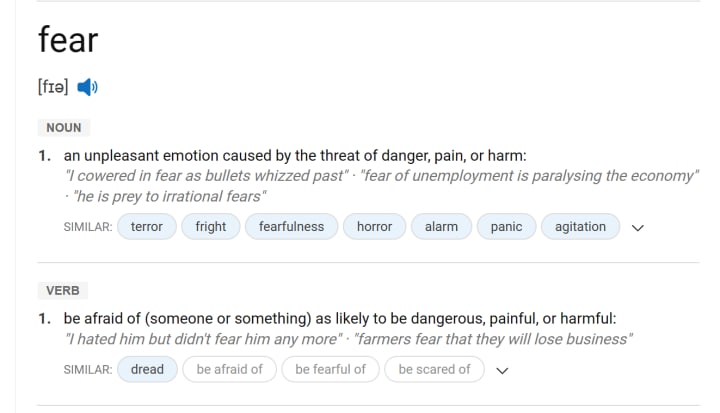F.E.A.R — False Expectations Appearing Real
Because they may be.

I am a big fan of Les Brown, and the title of this blog comes straight from one of his speeches. I have been listening to Les Brown for over five years but only recently made complete sense of this phrase. In this article, I will explain — Why and How?
What is fear?
Powerful quotes and powerful speeches bring motivational speakers fame and business. Their content is flawless, but their effect lasts for a few hours or, at max, a few days. I like to feel these quotes to grow in my life. To do so, I will put each speech on repeat and then dissect every part for a long-lasting effect.
I followed the same process after listening to the phrase:
F.E.A.R — False Expectations Appearing Real
The dictionary meaning of the word — “FEAR.”

Amygdala: A workaholic psychopath
The brain produces emotions like FEAR. If the brain is a multinational organization, the Amygdala is a workaholic psychopath. The Amygdala is an almond-shaped cluster of cells located near the base of the brain. Possibilities of physical harm stimulate the Amygdala.
The amygdala prepares our bodies to safeguard us from physical damage. During pre-historic times, it had a purpose. We were always on the run for food, shelter, and safety.
In today’s world, Amygdala does not have much work to do. We have houses to live in, food to eat, and laws to protect us. The possibility of a sudden attack is minimal compared to pre-historic days. Hence, the Amygdala fills in the remaining hours by generating anxiety.
The amygdala creates anxiety for fun even though it does not fit its job description. Isn’t that a typical behavior of a workaholic psychopath?
Thinking Fast and Slow

It’s easy to blame the Amygdala during these anxious times. The brain is a complex masterpiece. I needed to know more to find a way to tame my brainless brain.
Hence, I will shift my focus from the Amygdala to something else. I need to understand why fear paralyzes us from exploring things in life. After some reading, I could find the answer in the book ‘Thinking Fast and Slow” by Daniel Kahneman.
In this book, Nobel laureate Daniel Kahneman published about two thinking systems . Dan calls these systems the Fast & the Slow brain. These systems are not disparate parts of the brain. One should not confuse them with hemispheres. These systems are like agents who work with each other to help us finish any task.
Fast brain - Thinking fast
Fast thinking handles easy and mundane tasks like sitting on a chair. It’s not demanding and performs the job without sweat.
Let’s try and understand this with an example of a smartphone. In today’s world, a smartphone is a necessity. A smartphone allows us to do many things on the run, like sending a WhatsApp message or browsing news.
Besides the usual wear and tear, the smartphone performs as per expectations. You open apps with the help of a touch, do your task, and move. Easy-peasy, isn’t it? The screen of the smartphone is the starting point of any activity. It’s the front door that accepts all requests.
Like the screen of a smartphone, the fast brain is the front door for any task taken up by the human body. Its role is to find the easiest way to process the job and move on to the next one.
When the task is complex, it’s scared and anxious and calls for help. The help comes from the other system Dan mentioned in his book. This system is the Slow Brain.
Slow Brain………….Thinking slow
The fast brain activates the slow brain when the fast brain cannot find an easy solution for a problem—for example, solving a complex mathematical problem.
I will again use the example of the smartphone to explain the functioning of the slow brain. Let’s say you are using your smartphone to attend a conference call. While listening to others, you perform many other tasks on the phone.
The phone’s battery drains fast, and you switch it to low power mode to finish your call. Using the smartphone on low power mode will impact performance and display.
The Slow Brain works the same while working on complex tasks. It’s like a smartphone in low-power mode. The slow brain invests all its energy into the most critical task. While the slow brain works on this crucial task, our body gives physical cues.
In his book, Dan explains how pupils react when asked to work on complex tasks. It's a sign of the stress the body goes through. Dan and his team could predict the outcome of the tasks by looking at the pupils.
The pupils dilate while performing a difficult task. Dan and his team documented the changes in the subject’s pupils during the experiment. “The pupils reflect the extent of mental effort in an exact way,” Kahneman said
Dan has used the experiment of the “Invisible Guerrilla” to prove this fact. Dan showed how people could not see the guerrilla when assigned a complex task.
How does the brain create fear?
Our fast brain always looks for a straightforward solution. It registers the tiring experience during all complex activities. Whenever similar requests arrive in the future, it warns our body of the pain.
The fast brain would use the experience to stop us from taking up another challenging task.
I will explain this with another example. A prevalent form of anxiety is Dental anxiety. I have had some complex dental procedures. It had caused physical and financial pain. My experience has become a source of anxiety whenever I visit a dentist.
Dental pain is one of the worst pain a human body can experience. A dental infection has the capability of a heart attack.
But is there a guarantee that we will feel the same pain every time we step into a dental clinic? No. The fast brain’s role creates a FALSE EXPECTATION of the pain, BECOMING REAL.
Isn't this the same behavior with patients dealing with PTSD (Post-traumatic stress disorder)
Dan has used the experiment of the “Invisible Guerrilla” to prove this fact. Dan showed how people could not see the guerrilla when assigned a complex task.
What is the solution?
Unfortunately, we live in an era where we want answers for everything. We invite a lot of trouble with that attitude, unfortunately. The most straightforward answer is not the immediate solution. I understand that the answer is being mindful — yes, aware.
Mindfulness will not alter the behavior of the slow and fast brain. It will improve the way we cope with it. In short, it gives us ways to handle our anxiety.
While using our smartphones, we cannot increase the battery life, yet we can be mindful of the phone’s usage. We can use a power bank or FFS; leave it in our pockets for some time.
Aren't we tired of running after things? One of the reasons meditation and spiritual living are becoming status symbols. We want to experience everything and earn millions. We want to become Einstein and Zuckerberg. In this mad rush, we have forgotten to visit the most adventurous and fulfilling planet — the world within us.
Reading this book showed the importance of taming my brain. It motivated me to start the practice of meditation to empower my slow brain. Hence, I attended Vipassana in 2018. Ever since, I have practiced meditation regularly.
Know thyself — a phrase coined by Socrates but barely understood by most readers — is the place to be. It’s an essential task to tick it off our bucket list. It’s more than just necessary. It’s critical. Critical! If we want to be the masters of our minds and the captain of our fate — we must know ourselves.
Tarun
P.S - I published the original version of this story on Medium in the year
Glossary
- (3) Les Brown — Fear Is False Evidence Appearing Real! — YouTube
- Amygdala: Anatomy, Location, and Function (verywellhealth.com)
- What Part of the Brain Controls Emotions? Fear, Happiness, Anger, Love (healthline.com)
- Les Brown (speaker) — Wikipedia
- Evolution of the Amygdala — Creighton University (elsevier.com)
- Anxiety vs. Fear | Psychology Today
- Amygdala Hijack: What It Is, Why It Happens & How to Make It Stop (healthline.com)
- Anxiety vs. Fear | Psychology Today
- Thinking, Fast and Slow Book Summary by Daniel Kahneman (shortform.com)





Comments (2)
Your inspiring and insightful story unfolds this unpleasant emotion of fear so beautifully. I loved this piece very much.
great work why cant you join my friends and read what I have just prepared for you